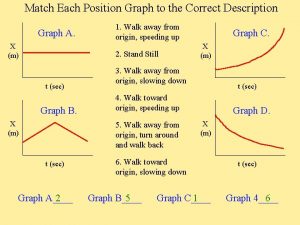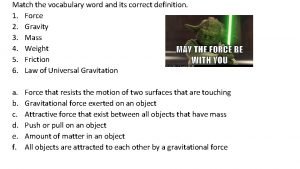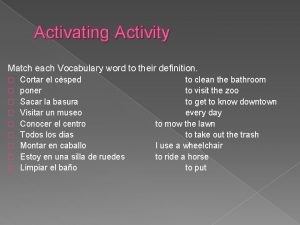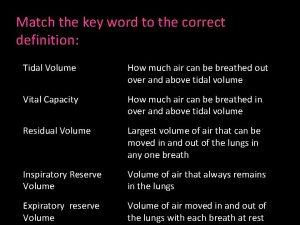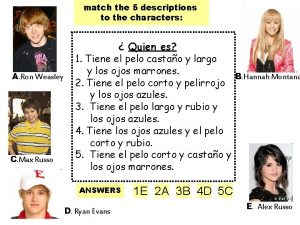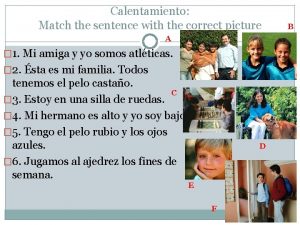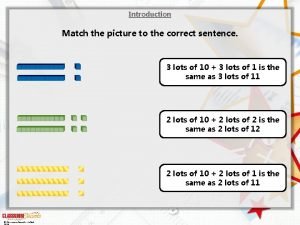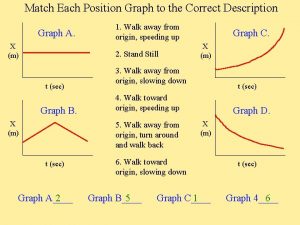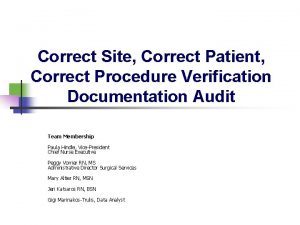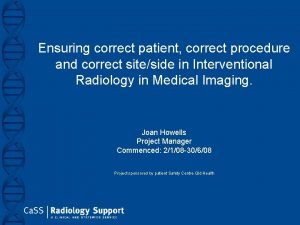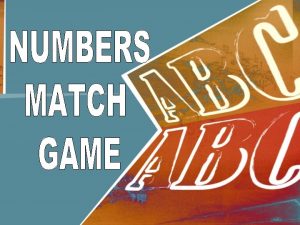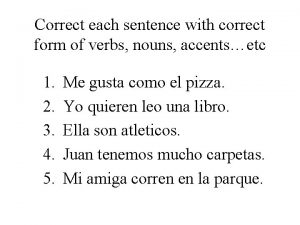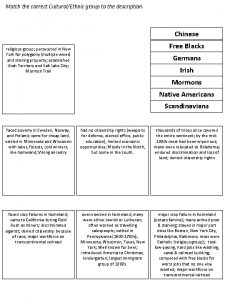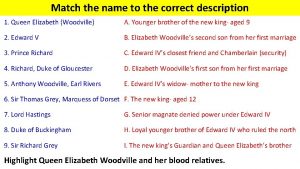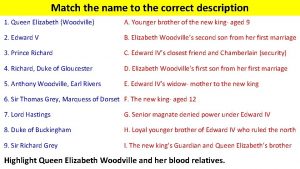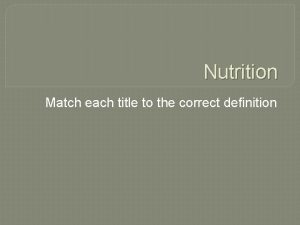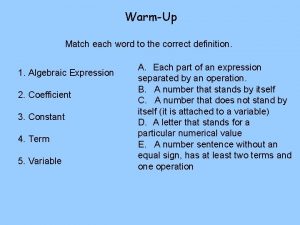Match Each Position Graph to the Correct Description


















- Slides: 18

Match Each Position Graph to the Correct Description Graph A. X (m) 1. Walk away from origin, speeding up 2. Stand Still t (sec) Graph B. X (m) Graph A____ 2 X (m) 3. Walk away from origin, slowing down t (sec) 4. Walk toward origin, speeding up 5. Walk away from origin, turn around and walk back t (sec) Graph C. Graph D. X (m) 6. Walk toward origin, slowing down Graph B____ 5 Graph C____ 1 t (sec) Graph 4____ 6

Match Each VELOCITY Graph to the Correct Description V (m/s) 0 Graph A. t (sec) Graph B. t (sec) 1. Walk away from origin, speeding up, then slow down V (m/s) 0 2. Stand Still 3. Walk away from origin at a steady pace 4. Walk toward origin, speeding up 5. Walk away from origin, turn around and walk back V (m/s) 0 Graph C. t (sec) Graph D. t (sec) 6. Walk toward origin at a steady pace Graph A____ 3 Graph B____ 1 Graph C____ 6 Graph D____ 5

Which Object is Moving Faster (Greatest Speed)? Graph 3. B Graph 1. X (m) A B t (sec) B Graph 2. X (m) A t (sec) A. Line A Graph 1____ A The magnitude of the slope of a position graph indicates the speed. The sign of the slope indicates the direction of the velocity. B. Line B Graph 2____ B C. Tie X (m) A t (sec) Graph 4. A X (m) B t (sec) D. Can’t Tell Graph 3____ C Graph 4____ B

Which Object is Moving Faster (Greatest Speed)? A. Line A B. Line B C. Tie B V (m/s) A 0 t (sec) D. Can’t Tell The speed is indicated by the distance from the X axis on a Velocity graph Which Object is Ahead? A. Line A B. Line B C. Tie D. Can’t Tell A velocity graph does not indicate the initial position of the object. B could have had a head start.

Which Object is Moving Faster (Greatest Speed)? A. Line A B. Line B E. First A, then B C. Tie D. First B, then A Make sure you B V always look at (m/s) A the graph axes to 0 t (sec) see what type of graph it is Which Object is Ahead? A. Line A B. Line B C. Neither D. Can’t Tell What Does the Intersection Represent? A. They have the Same Position B. Same Velocity C. Same Speed, Opposite Direction D. They Turn Around

Create a Velocity Graph from a Position Graph (3. 0, 3. 5) Slope = 0 ∆x Velocity = 0 (0. 5, Velocity 1. 0) is∆tthe Slope of the Position Graph

Create Position Graph from a Velocity Graph Does the Velocity Graph tell you Where to Start? No! Need to be given the initial position

Line Stays at 1 m while Velocity is Zero How Far Do You Go from 3 to 6 seconds?

You end up at 2. 5 meter Position at 6 seconds How Far Do You Go from 6 to 9 seconds?

You End Up Back Where You Started What Does the Graph Do Next?

What is Average Speed While Moving? What is the Average Velocity While Moving?

Area “Under” a Velocity Graph is Displacement More Correctly, It is the Area Between the line and the X axis 0. 5 m/s 3 s = 1. 5 m -0. 5 m/s 3 s = -1. 5 m +1. 5 m Area below X axis is negative displacement -1. 5 m

Area “Under” a Velocity Graph is Displacement, even when Velocity Line has a Slope

Area “Under” a Velocity Graph is Displacement, even when the Velocity Line has a non-zero Slope Area = 4 s . 5 m/s = 2 m Area = 1/2 4 s 0. 5 m/s = 1 m Area = 1/2 2 s 0. 5 m/s = 0. 5 m Decreasing Slope Increasing Slope Constant Slope

Also, Displacement is the Average Velocity times the Time

E&P #17 + Position is The velocity negative to theis 0 the of slope left the origin - The velocity is the slope 1. When, if ever, is the animal to the left of the origin on the axis? (A) never (B) between t = 0 and t = 2 (C) none of these (D) between t = 2 and t = 4 (E) between t = 4 and t = 7 3. When, if ever, is its velocity positive? 2. When, if ever, is its velocity negative? (A) never (B) between t = 3 and t = 7 (C) none of these (D) between t = 0 and t = 3 (E) between t = 2 and t = 4 4. When, if ever, is its velocity zero? (A) around t = 1 (B) at t = 3 (C) between t = 2. 5 and t = 4. 5 (D) never (E) at t = 0 (A) always (B) between t = 3 and t = 7 (C) none of these (D) between t = 0 and t = 3 (E) never

E&P #19 1. What is the total distance covered between 0 and 16 seconds by the runner whose velocity is shown above? (A) 128 m (B) 80 m (C) 100 m (D) Can’t tell (E) None of the above

Which Graph Shows the Velocity of a Ball Thrown Straight Up, After it Leaves Your Hand? A V (m/s) 0 t (sec) C V (m/s) 0 0 t (sec) V (m/s) 0 E t (sec) B t (sec) D t (sec)
 Match each graph with the correct description
Match each graph with the correct description Match the wave term to its correct description.
Match the wave term to its correct description. Match the terms below with their correct definitions
Match the terms below with their correct definitions Match each word to its definition
Match each word to its definition Match each sentence to the correct sentence type
Match each sentence to the correct sentence type Match each vocabulary word to the correct meaning.
Match each vocabulary word to the correct meaning. Match each key term with the correct definition
Match each key term with the correct definition Match each sentence to the suitable picture:
Match each sentence to the suitable picture: Second position
Second position Whmis 2015 test answers ccohs
Whmis 2015 test answers ccohs Match the characters with their descriptions
Match the characters with their descriptions Match the festival with the correct picture.
Match the festival with the correct picture. Match the correct type of fire to the appropriate class
Match the correct type of fire to the appropriate class Match the sentences with the correct picture
Match the sentences with the correct picture Match the terms with their correct definitions
Match the terms with their correct definitions Match the sentences to the appropriate verb mood.
Match the sentences to the appropriate verb mood. Match the picture with the correct sentence
Match the picture with the correct sentence Match the words with their correct meanings
Match the words with their correct meanings Match the correct meaning
Match the correct meaning
